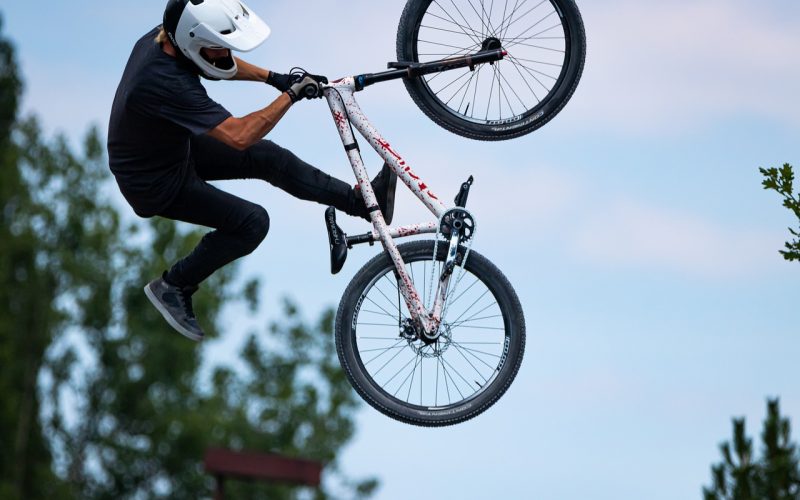As a mountain biker, your bike is incredibly precious to you. It helps you tackle the unbeaten track, take your skills and tricks to the next level, and is also a part of your biker identity. As an integral part of your evolution as a cyclist, it feels very personal to you.
Off-the-shelf mountain bikes are designed to elevate your performance and support you on your biking journey. But as you cycle along the unbeaten track, you start paying more attention to the details. Perhaps you feel like a different type of geometry would better suit your build, or you would like a certain set of gear-change and braking componentry.
Whatever the reason is, there are a number of ways you can customise your mountain bike to best suit you.
Why are people customising their bikes?
As the weather starts to warm up around March, bikers start riding the customisation wagon with full force up until October. The autumn and winter months are a bit quieter in the customisation realms, along with the bike rides.
Intriguingly, the spring/summer of 2020, which coincided with the start of the pandemic, saw the biggest boom in Google search volumes for “bike customisation”. While in 2019 the highest search volumes were 2,900 searches in July, September, and October, in May and June 2020, Google search volumes reached a whooping 3,600 searches.
Currently, we’re getting ready to tackle the off-the-road trails, so it’s the perfect time to start thinking about customising your mountain bike. Whether you’re a professional cyclist or an enthusiast, you probably already have a good understanding of the functions and parts of your bike, as well as your cycling goals.
With that in mind, customising your bike can help you elevate your riding style, boost your performance, and make you feel like a cycling superstar. Here is what to consider when giving your old mountain bike a revamp or designing a new one.
Bike frame
Generally, mountain bikes have smaller, sturdy frames, complemented by wider tyres. This structure allows it to tackle muddy trails, rocks, debris, and even jumps and climb.
Low-end bikes usually feature a high-tensile steel or aluminium frame, while intermediate to high-end mountain bikes feature Chromoly steel, titanium, or carbon fibre frame.
Nevertheless, you can play around with the bike frame and change it up by having a custom paint job and applying a different bike frame material.
For example, you can repaint your whole bike to reflect your favourite colours or add a splash of colour or two to some of its components, such as the bike frame or the handlers. A custom paint job can do wonders in terms of personalising your bike, and you can turn to a graffiti artist, for example, to add their artistic magic to your bike.
Moreover, off-the-shelf bikes usually come with clear-coated bike decals, which you can easily remove and apply new ones to your liking. You can even design your custom vinyl decals! They not only add a personal flair to your bike but also protect the frame from scratches. Alternatively, you can fully remove all (or some of) the decals for a cleaner, more simplistic look.
Bike-building expert Gustav Gullholm (aka Dangerholm) advises:
“Try not to have more than three different colours on your bike. For example, if you have a black frame, you can add some white and red details (e.g. decals and components). But as soon as you add a fourth or fifth colour, it all becomes messy-looking. I’m not saying that it can’t work but that it rarely does. Keep it simple.”
Suspension is really important when it comes to mountain bikes, and everyone’s preferences differ, but, thankfully, most modern-day suspension systems have adjustable settings.
You can choose whether you want a hardtail or full suspension bike. A hardtail mountain bike is one that only has front suspension, also referred to as a suspension fork. The suspension fork is essential as it helps with control and comfort. A full-suspension bike has both a suspension fork and a rear suspension. The latter adds more weight and most competitive riders swear by it.
Wheel size
While 26-inch wheels used to be the standard for mountain bikes, nowadays ‘the bigger the better’ seems to be the wheels mantra. The 26-inch wheels can still be found on jump bikes, junior bikes, and extra-small mountain bikes.
Then the 29-inch wheels were introduced. They offer lower rolling resistance and increased grip, which makes them ideal for hardtails. Nevertheless, the additional weight rotational inertial meant that they weren’t a perfect fit for full-suspension and downhill racing mountain bikes.
That’s why the 27.5-inch wheels were introduced, as they’re much lighter than the 29-inch ones yet have better grip and lower rolling resistance than the 26-inch wheels.
Depending on the purpose of your mountain bike, you can experiment with different wheel sizes to see which works best for you.
Mountain bike pedals
Stock pedals aren’t included with mountain bikes, which provides you with a great opportunity to choose your own.
According to Bike Radar, “What’s right for you will depend on where you ride and how you ride, but the first decision you need to make is whether you want flats or clipless”.
Flat pedals are literally a platform for your foot. They’re double-sided and usually have strategically placed pins to provide you with some extra grip.
Clipless pedals, or also called SPD pedals, on the other hand, “are a bit of a misnomer since they clip onto special cleats mounted on the soles of your shoes”, says Bike Radar. They’re also double-sided and are preferred by some bikers because they provide a sense of stability and pedalling efficiency due to the connection with the bike.You not only have a choice in terms of which type of bike pedals to choose but also which colour. Let your creative side flow and decide if you want to match your pedals’ colour with the handlebars, for example, or a different component.
Brighten your bike
You don’t have to spend a fortune on customising your bike with fancy components to make it uniquely yours. Whether you prefer a sleeker style or would like to be adventurous in your design choices, there is an array of exciting and affordable customisation hacks.
Bike stickers are also a great way to customise your bike and show your loyalties to a particular bike crew.
You will likely spend a good amount of time looking at your stem when going uphill on your mountain bike. Brighten your view by adding funky patterned stem caps with images or slogans. Did you know that you can even get a bike cap with a clock fitted into it?
The handlebars also provide an opportunity to brighten up your bike. They usually come in plain black, but you can add any colour or pattern through grips, bar tape, or hood covers.
There is a whole range of both model-incorporated and aftermarket customisations you can consider. From wheel size and bike breaks to gadgets and colours, the playground is yours to explore.
Sources
https://www.bikeradar.com/advice/buyers-guides/best-mountain-bike-pedals/
https://www.redbull.com/se-en/how-to-pimp-customise-your-bike









